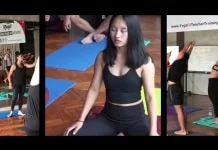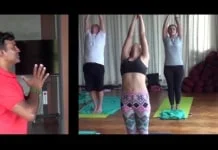When you get it up and running, it will give you peace of mind that you have a constant stream of new potential.
In this section, I’ll guide you through the six steps of creating your own yoga studio:
- Reflect on the topics you want to teach
- Discover your unique yoga style
- Craft your studio’s website
- Set your prices
- Create a user funnel to grow your community
If you follow each of these, you’ll be able to succeed as an online yoga teacher.
1. Reflect On The Niche You Want To Teach
You’re a yoga teacher with lots of hours on the mat. So, you already have a good idea of what types of content resonate best with your community.
When you’re moving your business online though, you need to establish a clear niche for your business. An area of expertise that will differentiate you from your competitors.
There is no right or wrong answer here. There’s just an honest answer.
Take some time to reflect on this. Think about what you want to teach as an online yoga teacher, and how it will benefit your yoga community.
You can also take a look at these online yoga studios for inspiration:
- SarahBethYoga
- TINT Yoga
- Outlaw Yoga
They all have different approaches to their yoga practice. Each is unique and incredible in its own way.
2. Create A Few Videos To Discover Your Style
Once you know what you’re going to teach it’s time to experiment.
You should dedicate some time to trying out different ways of teaching to the camera and find a style that feels comfortable for you.
There are three styles I suggest you try.
The first is studio presentation; this is where you instruct from your mat, as you would in front of a live studio class.
You can set this up quite easily and it’s a viewpoint your subscribers will be used to. It’s especially good if you have limited equipment, and it’s just you and your camera.
The second is class instruction; this is where you record your studio sessions and use them on your site.
This style is particularly good if you’ll live streaming your sessions. However, it can be a little impersonal. Use it sparingly!
The third is follow-along instruction; this is where you perform the flows for your students and provide instruction through voice-over.
This has become the go-to style for online yoga teachers because it stops you from having to multitask. There’s no need to talk while performing your different posts.
3. Create Your Online Yoga Studio’s Website
Your website is the storefront for your membership site. It’s where interested people will come to learn more, check your prices, and see if your style of yoga is right for them.
You must create a professional-looking video streaming website to attract the right people into your community. But don’t worry, you don’t need a degree in web design to do it!
Uscreen gives you the tools to make this easy. Our website editor is simple to use, and gives you complete flexibility control over how your studio looks:
You can choose from one of our flexible themes to get started, and then customize your site from there!
Take a look at these video streaming websites (all created using Uscreen) to see what’s possible on our platform and your eye for design:
- Wanderlust TV
- Find What Feels Good
- High Vibe TV
You can also browse more Uscreen examples right here.
Branding plays a large role in how your website looks and the community members you attract.
That topic is a little beyond the scope of this article, so I’ve called on our resident video-branding expert, Nick Nimmon, to break down the anatomy of a good fitness brand.
4. Pick a Pricing Model and Set Your Prices
Yoga instructors often struggle with pricing. It’s often hard to translate what you ask for in the studio to the online world.
Let’s start by briefly looking at how you can sell your videos. There are three conventional models you can use:
AVOD – Ad-Based Video On Demand
AVOD is when you don’t take payment for the video, and instead place adverts before, during, or after your video. Like how videos on YouTube and 4OD work.
I don’t recommend you use this when you teach yoga online. It’s an unreliable and unpredictable income stream, at least at the start.
TVOD – Transactional Video On Demand
TVOD is where you charge viewers to access a single video. You can either sell them unlimited access to the video or have them “rent” it for a specific period of time.
This model can be useful if you’re selling access to a specific course. Say, if you have an hour-long athletic yoga routine with lots of downloadable educational material.
The plus side of this model is that you can charge a higher price. The downside is that payments are not recurring and require constant marketing.
SVOD – Subscription Video On Demand
SVOD is the pricing model yoga instructors use to create strong, community-driven membership sites. It’s a model similar to what Netflix uses.
Your customers pay a monthly or annual fee for complete access to your videos. They can log in to your site and access content as long as they make their payment.
When you get it up and running, there will be new potential subscribers viewing your content and visiting your site.
Join Our Yoga Teacher Training And Main Event











































